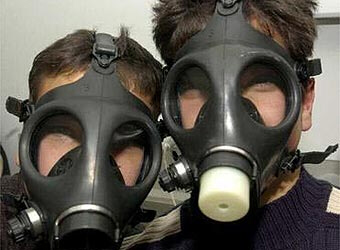
- Defective israeli gas mask how to#
- Defective israeli gas mask skin#
- Defective israeli gas mask free#
Depending on the type of filter used, a gas mask may provide short-term protection against some of the particulates found in smoke, but it won't protect against oxygen deficiency - smoke from a fire doesn't contain enough oxygen to support life.

Defective israeli gas mask skin#
(Sarin, for example, is colorless, odorless, and tasteless, but is rapidly absorbed through the skin and is many times more deadly than cyanide gas.)Īlso, a standard gas mask will filter out soot and keep smoke out of your eyes, but it offers little to no protection in a fire. While wearing a gas mask can offer significant protection in some environments, it's important to understand what it can and can't do, and to be well trained in its correct use.Ī gas mask will not protect the user against chemical agents that can be absorbed directly through the skin, such as sarin, mustard gas, tabun, and VX. The full-face mask also serves to protect the eyes and other vulnerable tissue, while allowing the wearer to see and communicate clearly. Although the science can get intricate, the basic purpose of the modern gas mask is designed to filter out harmful substances while allowing in clean, breathable air. The traditional gas mask, sometimes called a respirator, protects against noxious contaminants.
Defective israeli gas mask how to#
As late as 2013, Israelis routinely lined up to collect their gas mask kits and for demonstrations on how to use the gear correctly.
Defective israeli gas mask free#
Up until 2014, Israel's government distributed free gas masks to its civilian population. In today's unpredictable global environment, however, more and more civilians are also considering the benefits of including a gas mask in their personal survival kits. One hundred years later, law enforcement and military personnel around the world still use and train with gas masks.

Troops were expected not only to train with their masks, but also know how to clean and repair them.Īlthough there have been many significant advances in technology and materials since those early masks, the basic principle remains the same: filter out hazardous airborne contaminants and allow the user to breathe safely in hostile environments.

As result of this new threat, gas masks became so important to the battlefield solider that they were considered second only to the soldier's rifle. What's generally acknowledged as the modern-day gas mask dates back to the early 1900s.ĭuring World War I, soldiers encountered the first full-scale use of chemical weapons on the battlefield. Humans have never stopped trying to develop more effective forms of protection from toxic substances in the air. Most of these primitive masks were woefully ineffective, but perhaps they were better than nothing. The concept of the gas mask dates back to antiquity reportedly the ancient Greeks used common sea sponges to filter out smoke and other toxic substances. In this article we explore the gas mask basics, set aside myth and fiction, and provide in-depth answers to some of the most common questions.


 0 kommentar(er)
0 kommentar(er)
